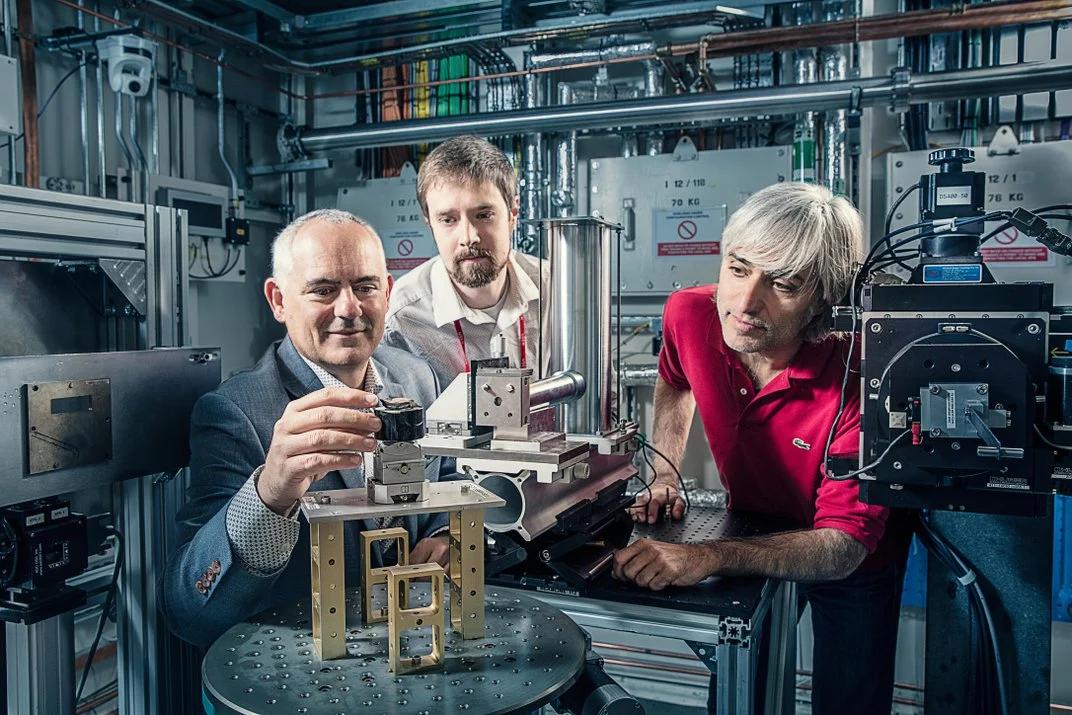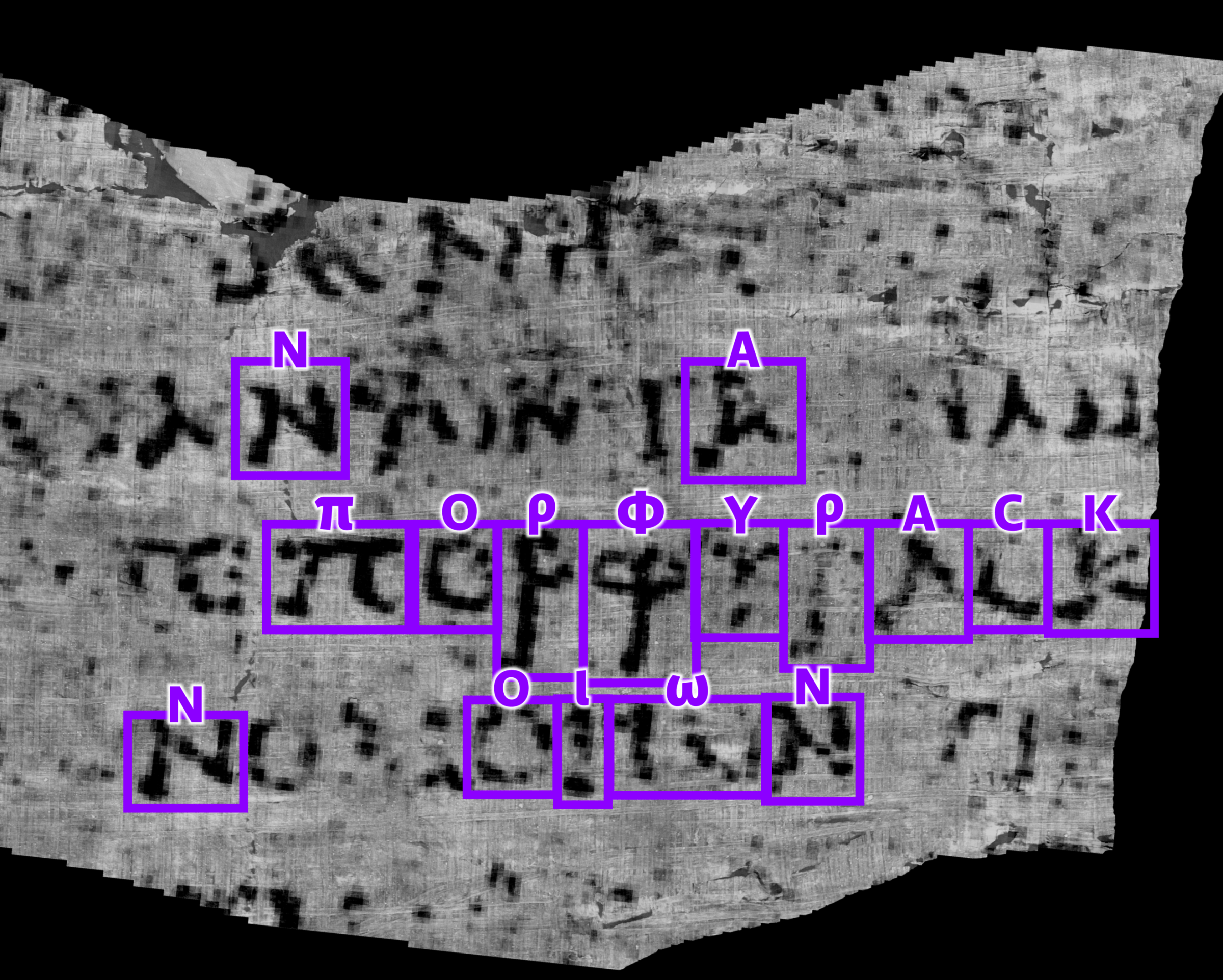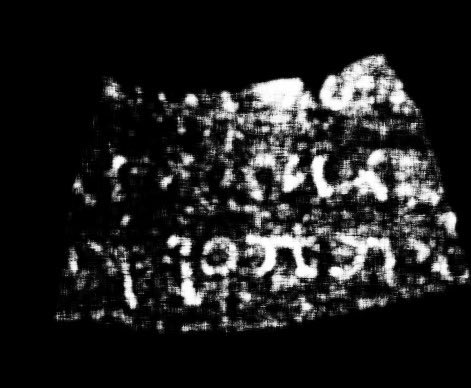On a Saturday night in late August, Luke Farritor, a 21-year old computer science student at University of Nebraska-Lincoln, was on his way home from a party at a friend’s house in Omaha when he saw something on his phone that he says almost caused him to break into tears and fall to the floor.
Farritor had spent the last six months poring over 3D X-rays of ancient scrolls, often for more than 40 hours per week, all alongside internships and his studies. While he was at the party he had received a message informing him that new segments of scanned and virtually flattened scrolls had just been uploaded. With the music blaring around him, he logged onto his PC remotely to set the AI model that he’d built to detect ink from previous scroll scans to work on the new segments and rejoined the party.
After driving home, on the walk back to his college dorm from the parking lot, Farritor remembered the scrolls and checked his phone.
On his phone display were three ancient Greek letters—π, ο, ρ (pi, omicron, rho). Farritor was the first to read the letters in nearly 2,000 years. “I completely freaked out,” he tells TIME.
Farritor, who on Oct. 12 won $40,000 for his breakthrough, is one of thousands of competitors racing to read the Herculaneum papyri, ancient Roman scrolls buried and preserved by a volcanic eruption. Farritor’s work builds on the work of the other competitors, for which 36 prizes have been handed out in total. On messaging platform Discord the atmosphere among competitors is collaborative—they share code and emerging results from their work alongside photos of pumpkins they bought and poems inspired by the competition—even as the dash for the $700,000 grand prize intensifies.
The competition is organized by the academic who invented virtual unwrapping and a tech investor who became obsessed with the Romans during the Covid-19 lockdown. Whoever wins, a bounty of ancient knowledge will soon be breached.
Where did the scrolls come from?
When Mount Vesuvius erupted in A.D. 79, it buried Herculaneum, a town in the south-west of Italy, under 65 feet of hot mud and gas. Just outside Herculaneum was one of the most luxurious villas in the Roman world, thought to be owned by Lucius Calpurnius Piso Caesoninus, Julius Caesar’s father-in-law.
Nearly 1,700 years later, farmers digging a well accidentally discovered the ruins of the villa. Among the treasures, they discovered a large number of what looked like lumps of coal. The lumps were in fact scrolls—also known as papyri, named for the papyrus they are made from—which had carbonized in the high-temperature, low-oxygen conditions created by the pyroclastic flows of the eruption. Many of the carbonized scrolls were thrown away before the excavators noticed a faint trace of letters, and began collecting them.
Over the years, multiple attempts have been made to unravel the scrolls, most of which destroyed them because they were so delicate. One of the more successful attempts was made in 1756, when Antonio Piaggio, who was curator of the manuscripts at the Vatican, invented a machine that painstakingly unraveled the scrolls millimeters at a time. It took four years to unroll the first scroll.
In 1802, King Ferdinand IV of Naples gave Napoleon Bonaparte six scrolls, which were then put in the care of the Institut de France in Paris. It’s rumored that later, the king gave the then British Prince Regent, later King George IV, 18 scrolls in exchange for 18 kangaroos, which were raised in the garden of the Villa Floridiana in Naples.
Scholars estimate there may be over 30 volumes of new text in the unopened scrolls, covering a wide range of authors and genres.
The invention of virtual unwrapping
Brent Seales, a professor of computer science at the University of Kentucky, was working in the British Library in London in 2002, where he and a colleague were building a digital edition of the Beowulf manuscript. One of the library conservators brought out a manuscript that couldn’t be opened because it had been too badly damaged.
“They said to me, ‘What about this one? What if you have a book and you can’t even open it to take photographs? What are you going to do about that?’” Seales tells TIME.
Seales developed a three-step method for reading scrolls without unwrapping them. First, take a 3D scan of the scroll using x-ray tomography, the same technology as that used for a CT scan. Second, analyze the scan to find the layers of scroll, and virtually flatten out the layers. Third, look for signs of ink in the flattened layers.
In 2002, he demonstrated his technique on artificially created scrolls at the Society of American Archivists. The audience, usually staid and professorial, audibly gasped, Seales says.
Virtual unwrapping proved its value in the real world when, in 2006, Seales used the technique to read a fragment that had been extracted from within the spine of another book. It turned out to be the text of the book of Ecclesiastes written in Hebrew. Another breakthrough came in 2015, when Seales and his team virtually unwrapped the En-Gedi Scroll, a carbonized fragment thought to be from the 3rd or 4th century.
Seales learnt of the Herculaneum Papyri in 2004, and scanned them for the first time in 2009. In 2019, in need of a higher resolution scan, he scanned two of the scrolls from the Institut de France at the Diamond Light Source, a particle accelerator in Oxford in the U.K. Earlier this year Stephen Parsons, one of Seales’ Ph.D. students, confirmed that machine learning could detect ink from the scans.

The Vesuvius Challenge
In early 2020, tech investor and executive Nat Friedman went down a rabbit hole after reading 24 Hours in Ancient Rome, a book that he admits is pitched at eighth graders.
“I very irresponsibly stayed up late finishing this book. I was CEO of [open software company] GitHub at the time, and I had early morning meetings. But I just loved it,” says Friedman.
Read More: The Most Famous Historian of Rome on Why Men Are Obsessed
For weeks, Friedman continued down the rabbit hole. He baked panis quadratus, a type of sourdough bread that archeologists found in Pompeii, also carbonized by Vesuvius’ eruption. “I got the heritage wheat that they used,” Friedman says. “It’s very good—tastes great.” He devoured books and Wikipedia pages about the Romans, becoming obsessed with the Romans before the subject became a social media phenomenon.
Eventually, he stumbled upon a Wikipedia page about the Herculaneum papyri, and learned about Seales’ efforts to decode them. In September 2022, when he hadn’t heard anything about the scrolls and eager to support Seales’ work, Friedman invited him to a 75-person glamping event he hosts annually in Sonoma Country, California, in the hopes that Seales might meet a funder or collaborator.
Friedman persuaded Seales to give a talk and herded people he knew to attend, but nothing came of it. “Brent was gonna fly back to Kentucky empty-handed. I was, frankly, distressed and embarrassed about this.” To remedy the situation, Friedman and his friend Daniel Gross met Seales in his hotel bar. There, inspired by his work with the open source software community as CEO at Github, Friedman pitched the idea of a contest—the Vesuvius Challenge.
“Brent said ‘I’ve been working on this for so long. And I think eventually I’ll get it, but I don’t know how long it’s gonna take—it could take a really long time. I just want to read the scrolls at this point.’” says Friedman. “That sort of became our mantra: we just want to read the scrolls.”
To get the prize fund started, Friedman and Gross each contributed $125,000. Friedman put on a “little Twitter telethon,” which raised $1.4 million. The grand prize, awarded to the first team to read “at least 4 separate passages of continuous and plausible text from the scrolls, each at least 140 characters long,” was set at $700,000.
The challenge launched this year on Mar. 15—the Ides of March.
About a week later, Luke Farritor was driving SpaceX’s Boca Chica launch site in South Texas, where he was working as an intern. Farritor put on a podcast and listened with a mounting sense of excitement as Friedman explained the Vesuvius Challenge.
“I was like ‘Holy cow, I have to give this a go,’” he says.
Upon arriving home from work that evening, Farritor set to work familiarizing himself with the data. Farritor says he has worked “more than I’m proud to admit,” on the scrolls since then, often staying up until 2am.
In June, Farritor read a blog post by another competitor, who had spotted what looked like ink while manually combing through the scans. Knowing what to look for, Farritor spent hours working over all of the unwrapped scrolls, finding around ten letters scattered across the surface.
The Vesuvius Challenge organizers were offering prizes for milestones on the way to decoding the scrolls. The largest intermediate prize—the first letters prize—was worth $40,000 and was to be awarded to the first team to find 10 legible letters in a 4 cm² area.
Using the ten letters he’d found scattered across the scrolls, Farritor trained a machine learning model—the same one he set running at the party that August Saturday night. After some tweaking, the results the model spat out—which show a word translated to mean “purple”—won him the first letters prize.

Throughout this process he was posting his results on X, the social media platform previously known as Twitter. Youssef Nader, a 26-year old computer science Ph.D. student at Freie Universitaet Berlin, took notice. Nader had spent the last two months working on the challenge for at least eight hours per day and sometimes up to 16 hours per day.
“It got to a point where it was really exciting to work on it,” he says. “I was unable to prioritize sleep. If I went to bed early, I would still wake up at the crack of dawn to check if that thing I tried yesterday worked or not.”
Nader had developed an approach which involved first training an unsupervised model—a model that did not have a labeled source of ground truth to learn from—on the scroll data, and then fine-tuned his model on the example fragment labels provided by the content organizers. He submitted his model for a smaller intermediate prize, which he won, collecting $1,500.
After seeing Farritor’s tweets with his early results, Nader began focusing on the same area of the scroll. He found a few letters, and fed them into his model which improved it, allowing him to see more letters. He continued to iterate until he discovered the same letters as Farritor had a few days earlier, winning second place in the first letters prize—worth $10,000. Nader has since used his technique to read a much larger section of the scroll that is in the process of being translated.

Both Farritor and Nader told TIME they intend to use their prize money to buy new computers—the extra computational horsepower will be required to have a shot at winning the grand prize.
Friedman has tried to maintain independence as referee. But independence is not the same as detachment. “I’m just addicted to this. I’m obsessed,” he admits. “I’m in the Discord every day.”
The grand prize expires at the end of this year. Because the two scrolls—which the Vesuvius Challenge team have christened “Banana Boy” and “Fat B-stard”—might not provide sufficient amounts of high quality data to train AI systems to spot letters, the team booked three more days at the Diamond Light Source in late September to scan the center sections of two partially unwrapped scrolls.
As Seales was due to fly from Italy to the U.K. with the scrolls, a storm hit, grounding all commercial flights. Friedman chartered a private jet. “Brent told me afterwards I’d ruined him for commercial travel,” he smirks.
“I think the grand prize will be won in 2023 on the original timeline,” predicts Seales, who is itching to read the scrolls. “It’s pretty intoxicating to sit down and see writing from someone 2,000 years ago.”
Read More: Why We Can’t Get Over the Roman Empire
The contestants are settling in for a less glamorous final stretch. “I think me and probably everyone involved, we want to go the extra mile and see how far we can push this,” says Nader, who has explained his situation to his forbearing Ph.D. supervisor.
Farritor, who hopes to continue work on decoding the scrolls after he graduates, says that although he’s feeling optimistic about his grand prize prospects, winning isn’t everything. “I just want to read the scrolls,” he says, reflecting a common sentiment in the community working to decode them. “We all just want to read the scrolls.”
Denial of responsibility! My Droll is an automatic aggregator of Global media. In each content, the hyperlink to the primary source is specified. All trademarks belong to their rightful owners, and all materials to their authors. For any complaint, please reach us at – [email protected]. We will take necessary action within 24 hours.


